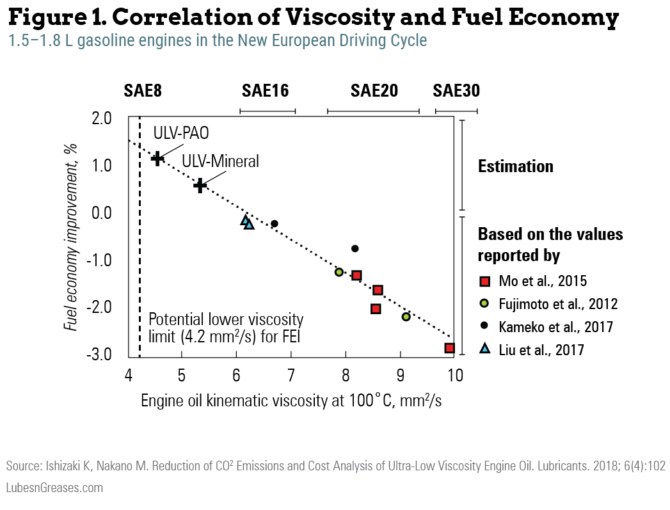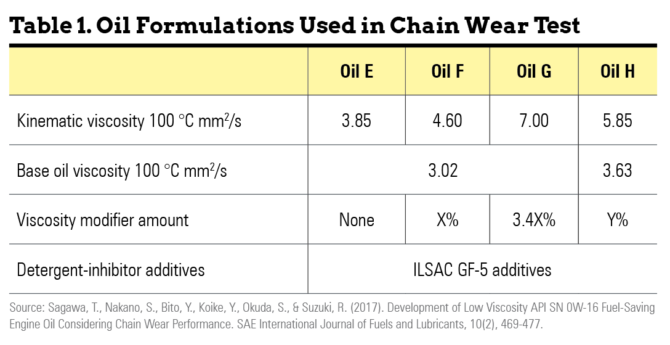
How can low-viscosity oils balance conflicting demands in modern engines?
While lowering engine oil viscosities has been a valuable part of meeting government-mandated fuel economy and emissions targets for automakers, thinner oils can increase wear as well as friction under certain conditions. It is vital to properly analyze all facets of low-viscosity engine oil in order to find a balance of the benefits and drawbacks of using these oils.
Recent research has affirmed the fuel economy improvements provided by a reduction in engine oil viscosity. Researchers at Keio University in Japan compiled fuel economy improvement values for an SAE 0W-16 oil with the corresponding kinematic viscosity of engine oils found in various studies, demonstrating the positive correlation between viscosity reduction and fuel economy.

The most commonly used grade of engine oils for passenger vehicles, SAE 5W-30, corresponds to a minimum 2% decrease in fuel economy compared to the reference SAE 0W-16 oil. The proposed ultra-low viscosity oils, ULV-PAO (polyalphaolefin) and ULV-Mineral, theoretically fall under the SAE 8 range and show a fuel economy improvement of 1.1% and 0.6% compared to the reference SAE 0W-16 oil. This corresponds to a minimum improvement of 3.1% and 2.6% in comparison to the SAE 5W-30 oils, respectively.
Even though there is great potential in lowering viscosity, the steady march toward thinner engine oils has also introduced a much greater disparity in wear protection between lubrication regimes.
Each lubrication regime depends directly on the oil film thickness and surface-to-surface contact. The main method by which low-viscosity engine oils improve fuel economy is the reduction of viscous drag under hydrodynamic lubrication conditions, where the film thickness of the lubricant is large enough to completely separate the two sliding surfaces and prevent any surface-to-surface contact.
The main deficit of low-viscosity engine oils is that they are more inclined to shear thinning at high temperatures and thicken less at lower or start-up temperatures than oils of higher viscosity. Both of these factors cause the lubricating film thickness to decrease. With decreasing film thickness, the lubrication regime shifts toward mixed and boundary lubrication. In the boundary regime, the oil film thickness cannot overcome the surface roughness. Mixed lubrication is the transition state between boundary and hydrodynamic lubrication with a film thickness that overcomes some but not all of the surface roughness.
“As you go to lower viscosity at low speeds, because of asperity contact, friction will go up,” explained Arup Gangopadhyay, powertrain tribology technical leader for Ford Motor Co. “At high speed in the hydrodynamic regime, you get the benefit of low viscosity. So overall, do you see a benefit? That needs to be balanced.”
Many studies have also correlated an increase in friction and wear with reduced kinematic viscosity. To understand the effects of low-viscosity engine oils on wear, researchers from Ricardo and Infineum subjected a heavy-duty truck engine to various conditions and lubricants, described in a 2013 SAE paper. Three test oils were run in an IVECO Cursor 13 Euro V engine: a baseline SAE 5W-30 oil with a kinematic viscosity of 12.28 millimeters squared per second at 100 degrees Celsius, a very low-viscosity oil with KV 6.53, and an ultra-low-viscosity oil with KV 4.82. On-line wear testing of the engine, in which continuous, real-time measurements are taken, showed that the baseline oil allowed the least wear.
Reduction of viscosity directly correlated to an increase in wear, particularly on the top piston rings of the engine. A post-test inspection and oil sample analysis for wear metals did not result in particularly elevated wear rates at any location not measured on-line; however, the camshaft thrust bearing had unexpectedly significant wear though it was deemed acceptable for continued use.
While heavy-duty vehicles require a higher viscosity grade than passenger vehicles due to higher load conditions—typically SAE 5W-40 to SAE 15W-40 versus SAE 5W-30—the effects of reducing viscosity, such as increased wear and friction at mixed to boundary lubrication conditions, are similar.
Additive Solutions
Currently, the most utilized method for improving wear prevention in low-viscosity engine oils is the addition of friction modifiers. These cost-effective additives improve friction during boundary and mixed lubrication where low-viscosity oils typically suffer.
In a 2019 SAE paper, researchers with Adeka Corp. described a study of three friction modifiers: molybdenum dialkylthiocarbamate, glyceryl monooleate and a polymer-type friction modifier for use in ultra-low viscosity engine oils.
The tribological characteristics of SAE 0W-16 engine oils with each friction modifier, as well as one control formulation with no friction modifier, were studied utilizing a cylinder-on-disc friction test with a load of 200 Newtons for 15 minutes, as well as a sliding-rolling-type friction test with a load of 30 N, mean rolling speed of 0.01 meters per second to 3 m/s and a slide-to-roll ratio of 50%. Afterward, each tribofilm was tested with a ball-on-disc friction test with a load of 2 N, a stroke of 5 millimeters and a sliding speed of 1 mm/s.
The cylinder-on-disc test results showed a friction coefficient of 0.05 for MoDTC, 0.10 for GMO, 0.13 for the polymer-type modifier and 0.15 for the control oil. The sliding-rolling-type friction test showed that the friction coefficient of the MoDTC formula decreased with oil age, and the friction coefficient of the control oil increased with aging. In contrast, the PFM and GMO oil formulas showed negligible change.
Comparing the results of the ball-on-disc friction test, the tribofilm generated from the MoDTC oil had the lowest coefficient of friction. MoDTC was chosen as the most effective at reducing friction and wear during boundary lubrication, which typically occurs during engine startup and high load conditions.
Another vital additive type for low-viscosity oils is viscosity modifiers, which improve the viscosity index of oils. The researchers at Keio University developed an API SN SAE 0W-16 engine oil with consideration to wear observed from the Sequence X chain wear test, which is included in the ILSAC GF-6 passenger car engine oil specification. The test utilizes a water-cooled, 4-cycle, in-line cylinder, 2-liter direct injection Ford EcoTech engine and oil temperature of 100 C, speed of 6,000 revolutions per minute, as well as 0.4 mass percent carbon black pre-diluted contaminant to simulate actual engine conditions. Oil formulations are listed in Table 1.

Surprisingly, the study showed little to no change in either chain elongation or oil film thickness among oil formulations E, F and G, while oil H showed an 11% decrease in chain elongation and a 30% increase in oil film thickness compared to oil E. This indicates that timing chain wear depends not on the kinematic viscosity of the fully formulated oil but instead on the base oil viscosity.
The main reason the viscosity modifier does not affect the chain wear test is the high surface pressure and thin oil film inherent to the test. These characteristics infer that mixed to boundary lubrication conditions are not conducive for viscosity modifier performance. The results also show it is possible to reduce the concentration of viscosity modifiers in base oils, such as those used in ILSAC GF-5 SAE 0W-20 oils, in order to lower their viscosities while maintaining the anti-wear effects of the base oil. However, this may introduce the possibility of oil thickening over time.
Conversely, a study published in Tribology Letters in 2018 by researchers with Imperial College London and Repsol utilized a journal bearing machine to show that viscosity modifiers reduce the friction of engine oils during hydrodynamic lubrication by two methods: shear thinning and increased viscosity index. Improved shear thinning allows for the oil viscosity to decrease with high engine speeds, reducing viscous drag and improving friction reduction up to 50% even at low temperatures. Increasing the V.I. reduces thickening at low temperatures and allows the engine to maintain hydrodynamic lubrication over a larger range of temperatures.
All of these properties contribute to the bottom line for automakers. Ford’s Gangopadhyay emphasized the benefit of high-V.I. engine oils with lower viscosity at lower temperatures, which add to fuel economy as a vehicle starts. In the United States federal test procedure for fuel economy, he explained, oils with lower viscosity at around 70 degrees Fahrenheit provide benefits early in the test.
He also expressed the need for improved and longer-lasting friction modifiers. “These are all small pieces, but if we can align them nicely, it can translate into a sizable benefit,” he said.
Beyond Wear Protection
As engine development progresses, engine oil viscosity is just one facet to consider when attempting to optimize both fuel economy and wear protection.
“It’s getting harder and harder to get fuel economy benefit [from lower-viscosity engine oils], but there is still low-hanging fruit there,” said Gangopadhyay. “In order to do that, we have to consider the hardware as well.”
It’s important to recognize that engine oils may serve purposes other than just lubrication and to ensure the oils are working with—not against—other methods of fuel economy improvement.
For example, nearly all modern engines are designed with cam phasing or variable cam timing devices, which work under hydraulic pressure from the engine oil. Lower viscosity means lower pressure, Gangopadhyay explained. “Does the oil still meet the minimum requirements of the device?”
Turbocharger bearings are also very sensitive to low viscosity, Gangopadhyay noted. “Are turbo suppliers going to design their bearings with low viscosity in mind?”
Ultimately, engine oils are meant to both maintain and improve the function of the engine. Regulations will continue to mandate increased fuel economy, and technology will advance. It is vital that research of friction and wear continues so that we may not neglect these underlying risks.
Raj Shah, Ph.D., is a director at Koehler Instrument Co. and an elected fellow of STLE, IChemE and the Energy Institute. Contact him at rshah@koehlerinstrument.com.
Isaac Kim is a chemical engineering student at SUNY Stony Brook and a technical services intern at Koehler Instrument Co.